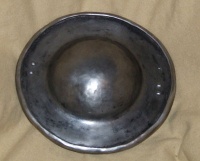Buckler: Difference between revisions
Paul Matisz (talk | contribs) m (Reverted edits by GabrielAkers (Talk); changed back to last version by Planish) |
|||
| (5 intermediate revisions by 4 users not shown) | |||
| Line 1: | Line 1: | ||
[[image:buckler.jpg|right|200px|thumb|Replica 15th century buckler.]] |
[[image:buckler.jpg|right|200px|thumb|Replica 15th century buckler.]] |
||
A '''buckler''' is a small [[shield]], used in both war with heavier single handed [[sword]]s and |
A '''buckler''' is a small [[shield]], used in both [[war]] with heavier single handed [[sword]]s and civilian [[duel]]ling with swords such as the [[rapier]]. They are usually between 8 and 12 inches in diameter, and primarily constructed of [[metal]] and sometimes had [[leather]] coverings. They were in common use from at least the [[13th century]] and were common sights for hundreds of years. |
||
The earliest surviving fencing manual [[I.33|Royal Armouries I.33]] demonstrates the use of this device with an [[arming sword]]. |
The earliest surviving [[fechtbucher|fencing manual]] [[I.33|Royal Armouries I.33]] demonstrates the use of this device with an [[arming sword]]. |
||
Of the shields ''per se'', it is probably the lightest, and easiest to move about. But, given that it is usually gripped by a handle across its back, it deprives its bearer of the use of the shield hand. That said, it is one of the easiest to attempt to have your opponent do a "nose-butt" on, just by putting it in the way. It also allows for a quite vicious back-hand rim-blow which could break the nose. |
Of the shields ''per se'', it is probably the lightest, and easiest to move about. But, given that it is usually gripped by a handle across its back, it deprives its bearer of the use of the shield hand. That said, it is one of the easiest to attempt to have your opponent do a "nose-butt" on, just by putting it in the way. It also allows for a quite vicious back-hand rim-blow which could break the nose. |
||
Swords and bucklers were, for a time, very much a fashion accessory for well-bred young men. The buckler, when not in use, was hung from the hilt of the sword, and the clatter of metal buckler on the metal sword hilt was a distinctive sound warning of the approach of a "swashbuckler", that is, an armed gentleman inclined to [[duel]]. |
Swords and bucklers were, for a time, very much a [[clothing|fashion]] accessory for well-bred young men. The buckler, when not in use, was hung from the [[hilt]] of the sword, and the clatter of metal buckler on the metal sword hilt was a distinctive sound warning of the approach of a "swashbuckler", that is, an armed [[gentleman]] inclined to [[duel]]. |
||
==Bucklers in the SCA== |
==Bucklers in the SCA== |
||
While historically most bucklers were round, [[SCA]] fencers have developed a number of other shapes and innovations. Most common of those adaptations are other shapes such as square, rectangular and kite |
While historically most bucklers were round, [[SCA]] fencers have developed a number of other shapes and innovations. Most common of those adaptations are other shapes such as square, rectangular and [[kite shield]]s. |
||
==External Links== |
|||
See [http://www.thearma.org/essays/SwordandBuckler.htm The Sword and Buckler Tradition] for a multi-page article with many illustrations from period sources. |
|||
[[category:shield]] |
[[category:shield]] |
||
Latest revision as of 23:18, 6 July 2010
A buckler is a small shield, used in both war with heavier single handed swords and civilian duelling with swords such as the rapier. They are usually between 8 and 12 inches in diameter, and primarily constructed of metal and sometimes had leather coverings. They were in common use from at least the 13th century and were common sights for hundreds of years.
The earliest surviving fencing manual Royal Armouries I.33 demonstrates the use of this device with an arming sword.
Of the shields per se, it is probably the lightest, and easiest to move about. But, given that it is usually gripped by a handle across its back, it deprives its bearer of the use of the shield hand. That said, it is one of the easiest to attempt to have your opponent do a "nose-butt" on, just by putting it in the way. It also allows for a quite vicious back-hand rim-blow which could break the nose.
Swords and bucklers were, for a time, very much a fashion accessory for well-bred young men. The buckler, when not in use, was hung from the hilt of the sword, and the clatter of metal buckler on the metal sword hilt was a distinctive sound warning of the approach of a "swashbuckler", that is, an armed gentleman inclined to duel.
Bucklers in the SCA
While historically most bucklers were round, SCA fencers have developed a number of other shapes and innovations. Most common of those adaptations are other shapes such as square, rectangular and kite shields.
External Links
See The Sword and Buckler Tradition for a multi-page article with many illustrations from period sources.
